| Article ID | Journal | Published Year | Pages | File Type |
|---|---|---|---|---|
| 5122831 | Public Health | 2016 | 7 Pages |
â¢The Green Prescription primary care intervention is effective over the longer term (2-3 years) for men and women.â¢Compliance in Green Prescription could be improved with more communication and collaboration between service providers.
ObjectivesThe rising incidence of non-communicable diseases in western countries is being driven by poor lifestyle choices, including increasingly inadequate physical activity. The aim of this study was to quantify the effectiveness of a physical activity primary care intervention named the 'Green Prescription' on changes in physical activity levels 2-3 year's following original prescription.Study designA retrospective study design using a telephone interview.MethodsPhysical activity and health information was gathered from participants in June-September 2015, who were originally prescribed a primary care physical activity intervention 2-3 years ago. Respondents were classified as either having completed the programme (adherence group, n = 91) or having not completed the programme (non-adherence group, n = 56).ResultsParticipants who had completed the programme within the past 2-3 years reported an additional 64 min (95% CI = 16-110) of total physical activity per week compared to those who had dropped out. Forty-two percent of participants in the adherence group reported increased physical activity levels after receiving the Green Prescription compared to 29% in the non-adherence group. The adherence group were less likely to be sedentary (odds ratio 0.7, 95% CI = 0.5-0.9) and more likely to meet the current physical activity guidelines of at least 150 min of physical activity per week (OR = 1.1, 95% CI = 1.0-1.3).ConclusionsThe findings indicate a long-term benefit is likely to participants who completed Green Prescription.
